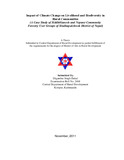Please use this identifier to cite or link to this item:
https://elibrary.tucl.edu.np/handle/123456789/2349| Title: | Impact of Climate Change on Livelihood and Biodiversity in Rural Communities: A Case Study of SiddhiGanesh and Nepane Community Forestry User Groups of Sindhupalchwok District of Nepal |
| Authors: | Dahal, Digambar Singh |
| Keywords: | Climate change;Livelihood;Biodiversity;Sindhupalchwok |
| Issue Date: | Nov-2011 |
| Publisher: | Central Department of Rural Development Tribhuvan University, Kathmandu |
| Abstract: | Climate change is contemporary global threat to the animal world. Green house gases are resulting global warming which is creating different impacts in the world. Because of human activities green house gases are increasing. Nepal's temperature is increasing at an alarming rate. Increasing temperature is creating different impacts on biodiversity, health the environment and other aspects of life of the animal world. Nepal is also facing the threat of climate change. This study was conducted on Sanosirubari VDC of Sindhupalchwok district during the period of February to September.2011 The main objective of the study was to assess the impact of climate change on agriculture; people's health; economy and on biodiversity. Interview survey, key informant interview, focus group discussion were conducted in collecting primary information. One hundred and twenty four households were sampled out of total 370 households (I.e., 62 from each CFUG) with random sampling for interviews survey. The data were analyzed using SPSS computer software. It was found that some special signs of climate change are experienced by rural communities of the study area. Local communities experienced increasing warm days and shortening cold/winter days. The pattern, intensity and amount of rainfall also changed, resulting in the scarcity of water. Moreover people started feeling of scarcity of water for irrigation and drinking. Climate change was affecting agriculture; production of main crops and cash crops has decreased. Different invasive species, pests and insects were increasing in farm. Many species of main crops such as rice, maize and millet species are in threat. Livestock are also affected from climate change, because of less germination of fodder. Number of livestock had decreased, resulting in declining incomes from livestock and related activities. Community members had experienced different new diseases resulting from including mosquitoes. Different health problems were increasing; especially women and children have been affected from itching problem, skin diseases, menstruation cycle, uterus infection (disease) and eye infection problem. On the other hand, flowering time of different species including shorea robusta, Aamala, maize etc was changed and so were the germination, harvesting and maturing times of different crops had changed. Income level from agriculture and livestock had decreased, so people are separating from their traditional occupation, way of life and they are seeking alternative professions. It is concluded that climate change is creating multidimensional impacts on the life of rural communities. Adaptation practices must be developed and awareness level of the people on climate change must be increased. |
| URI: | http://elibrary.tucl.edu.np/handle/123456789/2349 |
| Appears in Collections: | Rural Development |
Files in This Item:
| File | Description | Size | Format | |
|---|---|---|---|---|
| Final_thesis_digambar_dahal_RD_ICCLBRC_TU_Nov_2011.pdf | 5.09 MB | Adobe PDF |  View/Open |
Items in DSpace are protected by copyright, with all rights reserved, unless otherwise indicated.
